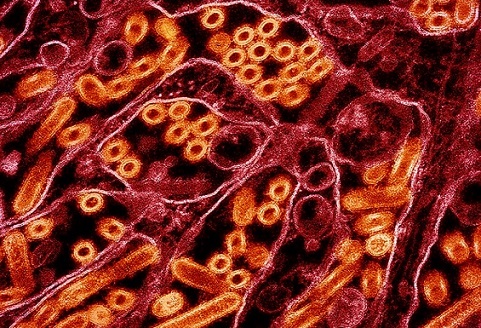Nikhil Prasad Fact checked by:Thailand Medical News Team Jan 09, 2025 10 months, 1 week, 3 days, 17 hours, 14 minutes ago
Medical News: Influenza A, a virus responsible for frequent global outbreaks and pandemics, remains one of the most significant threats to human health worldwide. Researchers have long studied the intricate ways the virus interacts with the human immune system to evade defenses and spread rapidly. A new study, conducted by scientists from the Chinese Academy of Medical Sciences in Beijing, Peking Union Medical College in Suzhou, and China Medical University in Shenyang, sheds light on an exciting discovery about how the body fights back against this virus.
 RTP4 Role in Stopping Influenza Spread
RTP4 Role in Stopping Influenza Spread
This
Medical News report focuses on receptor-transporting protein 4 (RTP4), a natural defense mechanism activated by the immune system. According to the researchers, RTP4 plays a pivotal role in blocking the influenza A virus by targeting one of its most critical proteins, NS1, and restoring the host's antiviral defenses. This finding opens new doors for potential therapies aimed at enhancing the body's natural resistance to the virus.
RTP4: The Immune System’s Secret Weapon
Influenza A thrives by suppressing the body's ability to detect and fight infections. One of its key strategies is using a viral protein called NS1 to shut down the body's innate immune response, particularly the RIG-I signaling pathway. This pathway is vital for activating interferons, proteins that help fight infections by disrupting the virus's replication process.
The new study identified RTP4, a protein produced in response to interferons, as a game-changer in the battle against the influenza virus. RTP4 binds to the NS1 protein, preventing it from interacting with RIG-I and other components of the antiviral response. By doing so, RTP4 effectively reactivates the immune system's ability to detect the virus and launch an attack.
Using advanced genetic and biochemical techniques, the researchers demonstrated that cells with reduced RTP4 levels were significantly more susceptible to influenza A infection. In contrast, those with higher RTP4 levels successfully resisted the virus. These findings underscore the critical role of RTP4 in defending against influenza.
The Science Behind RTP4’s Antiviral Action
RTP4’s ability to combat influenza lies in its unique structural features. The study highlighted three conserved CXXC motifs and a specific histidine residue within RTP4’s zinc finger domain as essential for its antiviral activity. These structural components allow RTP4 to interact with NS1 in an RNA-dependent manner, essentially "sequestering" NS1 and rendering it incapable of sabotaging the immune response.
This mechanism ensures that RIG-I, a key sensor of viral RNA, remains active and capable of triggering a cascade of immune responses. The study also revealed that mutations in the zinc finger domain of RTP4 eliminated its ability to bind NS1, confirming that this interaction is central to its antiviral properties.
Interestingly, the study f
ound that RTP4 does not directly interfere with the virus's ability to replicate its RNA. Instead, it focuses on restoring the host's immune signaling pathways, making it a unique antiviral factor. This approach highlights RTP4’s potential as a therapeutic target, offering a way to enhance the body's natural defenses without directly targeting the virus itself.
Broader Implications for Influenza Research
The discovery of RTP4's role in combating influenza represents a significant leap forward in understanding the complex interplay between the virus and the host immune system. Previous studies have shown that RTP4 inhibits other viruses, such as SARS-CoV-2 and flaviviruses, by directly binding to their RNA. However, this study is the first to reveal RTP4’s ability to combat influenza by targeting a viral protein rather than its genetic material.
The findings also raise intriguing questions about how RTP4 could be harnessed for therapeutic purposes. Could enhancing RTP4 expression in patients provide a new way to treat influenza? Or could this protein inspire the development of novel antiviral drugs that mimic its actions? Further research will be needed to explore these possibilities.
Conclusion
The study provides compelling evidence that RTP4 serves as a critical player in the host’s defense against influenza A infection. By targeting the viral NS1 protein and restoring the RIG-I signaling pathway, RTP4 reactivates the immune system’s ability to fight back. This breakthrough not only deepens our understanding of the virus-host interaction but also paves the way for innovative therapeutic approaches to combat influenza.
Moreover, the research highlights the potential of leveraging the body’s natural defense mechanisms to develop more effective antiviral strategies. As the threat of influenza pandemics looms, insights like these are invaluable in the global fight against infectious diseases.
The study findings were published in the peer-reviewed journal: Virology.
https://www.sciencedirect.com/science/article/abs/pii/S0042682225000091
For the latest Influenza News, keep on logging to Thailand
Medical News
Read Also:
https://www.thailandmedical.news/news/new-zealand-study-unveils-role-of-human-cellular-proteins-hdac1-and-hdac2-in-combating-influenza-a-virus
https://www.thailandmedical.news/news/conserved-human-t-cell-responses-to-h5n1-influenza-
https://www.thailandmedical.news/news/murine-study-reveals-dual-role-of-tlr7-in-influenza-a-infection
https://www.thailandmedical.news/articles/influenza-or-flu
https://www.thailandmedical.news/articles/h5n1-avian-flu
